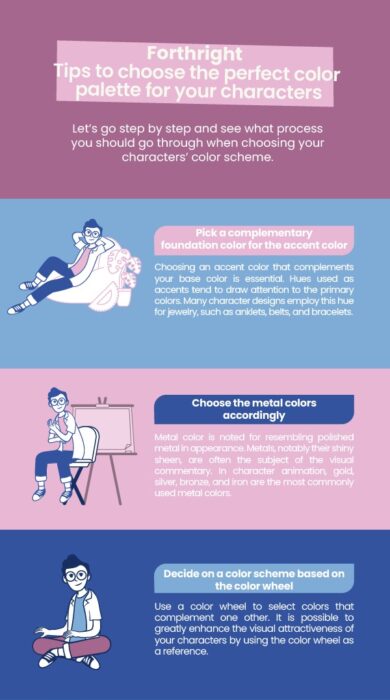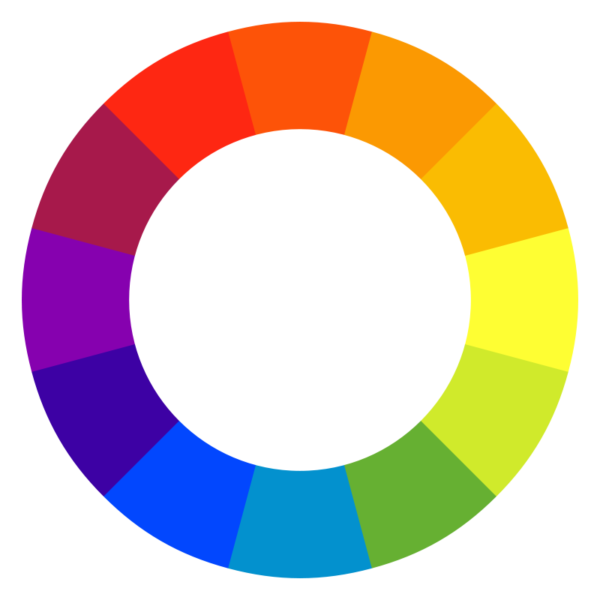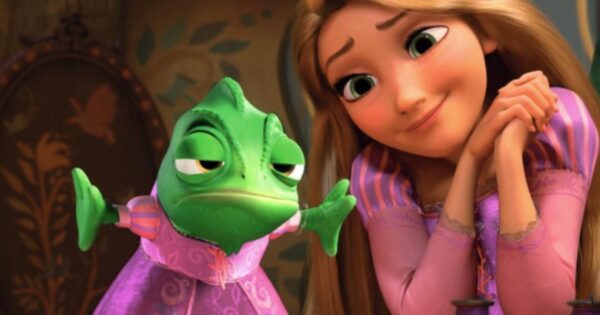So, you want to pick the best character color palette? Do you know character design color theory?
Most articles and instructions just provide you with a few color palettes and instruct you to utilize them as you see fit. When it comes to choosing the perfect character color palette, we believe that you should first learn character design color theory.
Stay with us till the end, and we’ll give you some gold nuggets for your character color palette and character design ideas!

Image Source: Screen Rant
In What Ways Might Color Theory Affect a Character’s Design?
Color theory for character design explains how human emotions, perceptions, and moods are affected by colors and how colors interact. It can be a crucial tool for color language character design, as it enables you create distinguishing, emotive, and memorable characters that express themselves, convey their mood, and explain their role in the story.
Many marketing organizations use animation to tell a brand’s narrative. However, consider this:
What will happen if you create a character without adhering to the universal laws of color theory?
Choosing the right color accounts for 60% of a product or service’s success or failure, according to several marketing studies. Consequently, your company’s income and lead generation are strongly impacted by the color scheme you choose for your animations.
According to a psychological study,
“Our subconscious mind is adept at making up meanings from different colors. If the colors evoke a sense of dislike, we won’t be happy looking at them.”
Similarly, if you don’t keep color psychology in mind while designing a character, they’ll look out of place and unrelatable.
In this blog today, we’ll explore everything you need to know about picking the right color palette for characters.
After that, we’ll go into more detail on how to pick the ideal color scheme for character design. As a final example, we’ve chosen one of our most popular character designs to serve as a case study.
What Messages Do Color Schemes Convey About a Company’s Values? (Designers’ guide to color theory)
Warm Colors like red, yellow, and orange are best when it comes to evoking warmth and energy. Cool colors on the flip side, like blue, green, and violet convey calmness and tranquility. Also, color harmonies are specific colors that work harmoniously. The best examples are all monochromatic colors.
For example, if you take the terms “Like” and “Love”, which one elicits greater emotion and dramatic effect? Which one would you like to use in your advertising campaigns?
Of course, LOVE! However, let’s take a detailed look at it.
Faber Birren, a well-known color theorist, discusses the relationship between color and human decision-making in his world-famous book Color Theory.
Emotionally charged colors like red and black have the same effect on individuals as words such as “Like” and “Love”.
Even in character design, a lack of action-inspiring color might be a clue that your characters have not been put together properly. As a result, your goal as a business should be to foster a strong emotional bond with your target audience so that they are more likely to buy or utilize your products.
Let’s explore how color palettes may improve or break a character design now that you have a better understanding of how color affects human psychology.
How to Select Color Schemes for Characters (4 Tried & Tested Methods)
Here is how you can do it:
- Choose a color scheme.
- Consider the context and mood.
- Use value and contrast.
- Experiment with variations and gradients.
- Test and refine your palette.
- Learn from other artists.
Let’s have a look at the steps involved in selecting the color scheme for your characters one by one.
Go with a bold color palette as the characters’ foundation
When it comes to character, foundation colors are the building bricks. Choose colors that are inside your foundation’s color spectrum as a starting point. The following are some of the top 3D animation base colors:
Natural tone colors: The term “earth colors” refers to colors that are derived from the natural components in our surroundings. Earth tone colors are basically any hue that has some brown, green, blue, and red, which are the colors of the ground, leaves, and trees.
Jewel-tone colors: The rich and saturated colors of well-known jewels include sapphire blue, ruby red, amethyst purple, citrine yellow, and emerald green.
Pastel tones: As the name suggests, these are light, faint colors. Their color density is lower than that of jewel-tone hues, which have a higher value. It is common in 2D animation design to use this style of color.
Cool, warm, or neutral undertones: Colors are divided into one of three groups based on their undertones. Generally speaking, warm undertones tend to be peachy, yellow, or golden in hue; cool undertones tend to have tints of pink, red, or blue; and neutral colors are a blend of these colors.
The results you get from using any of these color schemes as the basis for your characters will be vastly different. Your brand’s value, narrative, and message all play a role in determining the best way to communicate it.
4 Useful Tips & Tricks on Usage of Color Theory When Designing Character
In order to leave a lasting impression on your customers, it is more necessary than ever to use a variety of colors to create a memorable character. Color theory is a powerful tool that may help you boost the success of your marketing initiatives.

Pick a complementary foundation color for the accent color
Choosing an accent color that complements your base color is essential. Hues used as accents tend to draw attention to the primary colors. A lot of character designs employ this hue for jewelry, such as anklets, belts, and bracelets.
Select the appropriate metal hues
Metal color is noted for resembling polished metal in appearance. Metals, particularly their shiny sheen, are often the subject of the visual commentary.
In character animation, gold, silver, bronze, and iron are some of the most commonly utilized metal hues. The metal embellishments that go with your jewel-toned colors may also be a great way to make your character outfit more cohesive.
Decide on a color scheme by consulting a color wheel

Image Source: Wikipedia
Teal and orange are often used together in the background of Hollywood blockbusters to create a distinctly American feel. To put it another way, teal blue, which is the opposite of orange on the color wheel, and the correct warm oranges paired with teal create a vibrant room.
Use a color wheel to select colors that complement one other. It is possible to greatly enhance the visual attractiveness of your characters by using the color wheel as a reference.
Make an informed decision when using black
When it comes to character design, black is by far the most overused shade of gray. As appealing as it may be to use black as your character’s primary color, it is rarely the best choice for conveying your brand’s story or marketing message.
Moreover, it’s a cliche that won’t help you stand out from the crowded field of animation advertisements. As an accent color or a color that connects many other colors, black is preferable.
You can use black as your primary color, but consider employing a dark tone palette that includes grays and dark blues, and deep reds. Improves definition and creates a fuller appearance.
There are many ways to combine the principles of color theory and form theory in character design.
FAQs: Character Color Palettes and Their Usage in Character Designing
We’ve compiled a list of the most frequently asked questions on this topic for the benefit of our readers.

Image Source: Watch Mojo
How many colors should there be in an animated character?
Choosing a color palette for a character might lead to a cartoon storyboard that is a touch too colorful. The Cleveland Institute of Art recommends that a character have no more than three basic colors, although you can use more if you have a good reason for doing so.
You can see whether you have used too many colors by doing the following experiment:
Is your character making you feel dizzy and confused?
If the answer is affirmative, is it possible to reduce the number of colors? In order to keep things simple and effective, the finest animation companies choose to restrict the number of colors to three or four.
Let’s have a look at this example:
The characters in the left image look dull and uninteresting. In contrast, on the right side, color harmony is much more evident, which enhances the visual attractiveness of the characters.

What are the top color combinations of character animation?
Take a look at these three-color combinations that have worked well to get a sense of what works and what doesn’t:
- Green, yellow, and blue
- Turquoise, beige, and dark blue
- Yellow, blue, and red
- Brown, dark brown, and beige
What traits/characteristics do different colors represent?
Despite the fact that colors have a wide range of meanings in different cultures, these common representations of emotions are universal:
- Red represents ardor, ecstasy, and rage.
- Yellow represents deceit, hope, and happiness.
- Orange represents vitality, energy, and happiness.
- Green represents abundance, new beginnings, and nature.
- Blue represents responsible, sadness, and calm.
- Purple represents wealth, royalty, and creativity.
- Gray represents formality, conservative, and moody.
- Black represents evil, elegance, and mystery.
What are the four primary colors of personality?
Blue, green, gold, and orange are a few of the most often utilized hues for expressing one’s individuality.
How do you decide on a character’s color scheme?
Determine the emotional and psychological impact you want your character to have on the viewer, and then choose colors that reflect that feeling well. Use the correct forms so that you don’t end up with two distinct characters.
What about the colors of Disney characters?

Image Source: Screen Rant
Many designers and companies in the character design business look to the color palettes of Disney characters as role models for greater recognition in the industry.
So, we’re supposed to make all of our characters seem like they’re straight out of a Disney movie? If you don’t use this color palette’s adaptability to its fullest potential, you won’t have a color palette that stands out.
Try to grasp the rationale for each color you select for your color pallet. Let us know if you have any opinions or criticisms on this. We welcome your input.
Make your own style by stealing the concept of each character from Disney rather than copying their color palette.
Ready to get Your Eye-Catching Animated Character Designed? – Hire BuzzFlick
We know all these terms like color theory, color scheme, color palettes, and color psychology might be a bit overwhelming for you to understand if you’re a newbie in the world of animation.
If you don’t want to go into the complexities and still get your work done, you can hire any 3D animation production company.
But here’s a thing, if you want to get a high-quality, compelling, and creative animated character(s) for your videos, you can come to us.
We at BuzzFlick are offering various video animation services like motion graphics,2D animation, and 3D animation services.
Closing Remarks
Even whether you’re a marketing firm or a company that plans to develop a mascot, choosing the right color palette may have a significant impact on expressing the most critical information. This article will help you understand the right color palette for the characters and some of the greatest techniques and tactics that may completely change the brand’s perception.




